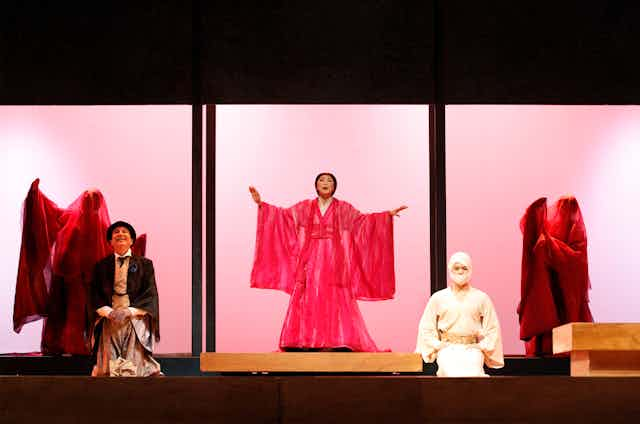There is a spectre haunting Opera Australia and it is the spectre of growing irrelevance.
Yesterday the Sydney Morning Herald reported that Opera Australia’s annual report for 2014 has posted an operating loss of A$2 million. That loss is down from A$2.4 million in 2013, but it was nevertheless described by Opera Australia chief executive Craig Hassall as “an outcome we cannot sustain over time”.
The Australian, meanwhile, notes that Opera Australia’s:
combined earnings from commercial shows including The King and I have overtaken ticket revenue for conventional opera seasons of Mozart, Verdi, and Puccini.
But this raises the obvious question of why the taxpayer should fund the national company (in partnership with a commercial producer) to perform repertoire in direct competition to commercial music theatre companies. It seems a problematic model of industry cross subsidy at best.
Such news comes in the midst of the federal government’s National Opera Review into Australia’s four major federally-funded opera companies (Opera Australia, State Opera of South Australia, West Australian Opera, and Opera Queensland), but also midst growing industry disquiet about the company’s choice of repertoire.
On Monday night the Melbourne season of Opera Australia opened with Madama Butterfly. It is shortly to be followed by Don Giovanni and Don Carlos. The first two of these three works regularly appeared appear in the top ten most performed operas in the world.

The third work, Don Carlos, is less regularly performed in Australia and elsewhere, but it is certainly standard repertoire.
But as Opera Australia’s artistic director Lyndon Terracini himself argued in a public address in 2011 any reliance on a sense of “patrician entitlement” by those who would cherish Australia’s links with our European past, is not compatible with the (if you will excuses the pun) tenor of Australian public life, or the character of contemporary Australia.
Terracini instead called for programming that was “popular but without being populist”, that put “the audience first and foremost”.
Getting that balance right, however, requires both sure judgement and confident advocacy. Arguably, simply giving audiences “what they want” is not enough, particularly if those audiences appear to come largely from a narrow socio-economic strata of Australian society.
The company surely would claim to offer more to Australian audiences than just another competing form of mass entertainment. If Australians are to continue to agree to sustain, tacitly via the taxation system, such an enterprise, the company needs also argue why opera continues to deserve such favoured treatment.
Arguments in favour might include its ongoing kinship with grander ideals of collective cultural enterprise, and civic engagement with the arts. As I have argued elsewhere, opera ultimately only justifies itself, financially as well as culturally, if it continues to help us evaluate and reflect upon the conditions of existence – no less.

Last month, for instance, the opera critic for the Spectator, Michael Tanner, wrote a review of Madama Butterfly under the heading Why I vow never to see Madama Butterfly again. But he offered no trenchant critique of the ubiquity of this this staple of operatic programming.
Instead, he declared:
What we are watching and hearing is the detailed and utterly convincing torment of a completely sympathetic woman, as she moves towards her tragic doom, set to gorgeous music, perfect in every bar apart from the long orchestral passage that links Acts II and III. Why do we do it, why do we crave it? I refuse to agree that Butterfly is kitsch or anything like it, and I can honestly say that I was upset for several days after seeing it. I have even vowed that I won’t see it again, at least until I can justify what seems an act of spectatorial masochism. The oldest, biggest question in aesthetics, and no one has produced an even plausible answer.
(Tanner is arguably mistaken on his last point. Nigel Spivey, for one, has a good go at proffering an answer in his book Enduring Creation: Art, Pain and Fortitude. Art such as Madama Butterfly, he suggests, both warns and consoles us about about the reality of human suffering, whether the cause be man-made or natural.)
There is a good case, then, for the continuing presence of Madame Butterfly in Australian culture life. But the broader case needs to be argued, not simply asserted or assumed. And it needs to be constantly refreshed.
This should not foreclose, however, debate about the overall efficiency of how our operatic dollar is spent, particularly if we also desire to see more frequent performances of lesser-known and contemporary Australian operas.
Sydney Chamber Opera’s premiere of Melbourne-based composer Elliot Gyger’s opera Fly Away Peter is currently receiving high critical praise.
Reviewer Murray Black writes of an “impressive achievement” that “deserves further performances [but] whether it will get them remains a moot point”.
And Sydney is also the home of Pinchgut Opera, whose mission is to “rediscover baroque and early classical opera masterpieces”. Both companies operate on comparatively tiny amounts of public funding.
In contrast, while claiming it is “desperate to create new work that is relevant to a significant audience”, Opera Australia says it simply does “not have the financial resources to do so”.
But innovation, local relevance, popularity, and value-for-money should not mutually exclusive demands on our flagship state-funded opera company.
As I have argued before on The Conversation, Opera Australia might need to accept a greater reputational, financial, and artistic risk in its programming lest it become, if not too big to fail, then at least too big to be much more than a producer of a narrow range of traditional operatic works, supported by American musicals.
No doubt this is an issue the federal government review will address. It is both right and timely that it does so.
Madama Butterfly by Opera Australia is currently showing at the Art Centre Melbourne. Details here.

